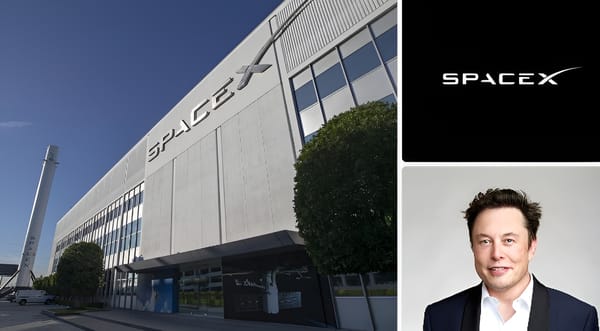
Investment Tagline: Invest in the Leader of Commercial Space Exploration and Satellite Internet
| Industry | Aerospace/Defense |
| Total Raised | $11.9bn (as of 2025) |
| Headquarters | Hawthorne, USA |
| Last Primary Valuation | $350bn (as of Dec 24) |
| Founded | 2002 |
| Caplight Valuation | $400bn |
About SpaceX
Space Exploration Technologies Corporation (SpaceX) is an American aerospace manufacturer and space transportation company established in 2002 by visionary entrepreneur Elon Musk. The company has fundamentally transformed the space industry by pioneering reusable rocket technology, dramatically reducing the cost of space access while pushing the boundaries of what's possible in commercial spaceflight.
SpaceX has achieved an unprecedented series of historic milestones: the first privately funded liquid-propellant rocket to reach orbit, the first private company to successfully launch and recover a spacecraft, the first private company to send a spacecraft to the International Space Station, the first vertical landing of an orbital rocket, and the first private company to send astronauts to orbit and the ISS. The company's fleet includes the highly successful Falcon 9 and Falcon Heavy rockets, which have demonstrated remarkable reliability and reusability with over 200 successful launches.
The company operates a revolutionary satellite internet constellation called Starlink, which has become the largest satellite constellation ever launched with over 5,000 satellites in orbit as of 2025. SpaceX achieved a $350 billion valuation in December 2024 through secondary share sales, and is in discussions for additional funding at a $400 billion valuation as of July 2025, making it one of the most valuable private companies in the world. With secured contracts exceeding $7 billion from NASA and $750 million from the US Military, SpaceX has established itself as the clear leader in commercial space technology.
Market Opportunity
Explosive Space Industry Growth
- Global space industry revenue projected to exceed $1 trillion by 2040 (Morgan Stanley)
- Current market size approximately $450 billion with strong growth trajectory
- Commercial space segment experiencing fastest growth in aerospace sector
- Government and defense contracts providing stable revenue foundation
Starlink Addressable Market
- Satellite internet market estimated at $1 trillion addressable opportunity
- 3+ billion people globally lack reliable internet access
- Enterprise, maritime, aviation, and government segments rapidly adopting
- First-mover advantage with 5,000+ satellites already operational
Long-Term Value Creation
- ARK Invest projects SpaceX base case enterprise value of $2.5 trillion by 2030
- Bear case: $1.7 trillion; Bull case: $3.1 trillion
- Multiple revenue streams: launch services, Starlink, government contracts, Mars missions
- Future hypersonic earth-to-earth travel creating additional transformational opportunity
Key Investment Features
• Extraordinary Valuation Trajectory: SpaceX valuation surged from $33.3 billion (May 2019) to $350 billion (December 2024)—representing 10.5x growth in 5.5 years. The company is in discussions for funding at $400 billion valuation (July 2025), positioning SpaceX among the most valuable private companies globally. ARK Invest projects base case $2.5 trillion enterprise value by 2030, implying 6x+ potential upside from current levels.
• Market Dominance Across Segments: SpaceX controls approximately 60% of the global commercial launch market, completing more orbital launches than all other countries and companies combined. The company operates four complementary business segments: (1) payload launch services, (2) Starlink satellite internet, (3) deep space missions, and (4) hypersonic earth-to-earth travel, creating diversified revenue streams and cross-platform synergies.
• Starlink Revenue Revolution: Starlink has achieved rapid commercialization with millions of active subscribers globally, generating substantial recurring revenue. The service addresses massive underserved markets in rural broadband, maritime connectivity, aviation internet, and emerging market internet access. First-mover advantage with 5,000+ satellites operational creates insurmountable competitive moat—competitors years behind in deployment.
• Reusability Cost Advantage: SpaceX's revolutionary reusable rocket technology reduces launch costs by 10x versus competitors. Falcon 9 first-stage boosters have been reused over 20 times, with some achieving 15+ flights. This cost advantage enables SpaceX to underprice all competitors while maintaining superior margins, creating a sustainable competitive position nearly impossible for traditional aerospace companies to replicate.
• Blue-Chip Strategic Backing: Backed by world's leading investors including Mubadala, Bessemer Ventures, 500 Startups, Sequoia, Lightspeed, Founders Fund, Goldman Sachs, Morgan Stanley, BlackRock, Fidelity, and strategic partners including NASA, Boeing, Lockheed Martin, Mercedes Benz, BAE Systems. $11.9 billion raised across ~30 funding rounds demonstrates sustained investor confidence.
Valuation Analysis
Current Valuation Framework
- Secondary market valuation: $350 billion (December 2024 employee share sale at $185/share)
- Funding discussions: $400 billion (July 2025)
- Caplight valuation: $400 billion reflecting latest transaction discussions
- Growth trajectory: 10.5x increase from $33.3bn (2019) to $350bn (2024)
ARK Invest 2030 Projections
- Base case: $2.5 trillion enterprise value
- Bear case: $1.7 trillion enterprise value
- Bull case: $3.1 trillion enterprise value
- Implied upside: 6.3x from $400bn to $2.5tn base case by 2030
Valuation Support Factors
- Launch market dominance: 60% global commercial launch market share with superior margins
- Starlink scaling: Millions of subscribers generating high-margin recurring revenue estimated at $4-6+ billion annually
- Government contracts: $7+ billion NASA contracts, $750+ million US Military contracts provide stable cash flow
- Technology moat: Reusable rocket technology 5-10 years ahead of all competitors
- Starship development: Revolutionary next-gen vehicle enabling transformational cost reductions and Mars missions
Market Context
- If public, $350-400bn valuation would place SpaceX among largest companies globally by market cap
- Secondary share sales demonstrate liquidity demand from employees/early investors
- Private valuations reflect sophisticated institutional investor pricing ($185/share)
- Valuation growth from tens of billions to hundreds of billions demonstrates exceptional investor conviction
Revenue Drivers Supporting Valuation
- Launch services revenue from commercial, government, and defense customers
- Starlink subscription revenue scaling exponentially with user base expansion
- NASA Artemis program contracts for lunar missions
- Starship deployment creating next-generation capability advantages
- Maritime, aviation, and enterprise Starlink segments in early growth stages
Strategic Advantages
Technology Leadership
- Reusable rocket technology: Falcon 9 and Falcon Heavy boosters reused 15-20+ times, reducing launch costs by 10x
- Starship development: Next-generation fully reusable super heavy-lift system with 100+ ton payload capacity
- Vertical integration: In-house manufacturing of engines, avionics, structures reduces costs and accelerates iteration
- Rapid iteration: Test-fly-learn-improve methodology enables faster advancement than traditional aerospace
- Starlink constellation: 5,000+ satellites operational with v2.0 satellites launching (10x capacity improvement)
Market Position
- Launch market dominance: More orbital launches than all other entities combined
- Government relationships: Trusted partner for NASA, US Space Force, Department of Defense
- Commercial contracts: Launch provider for majority of commercial satellite operators
- First-mover advantage: Years ahead in reusable technology and satellite constellation deployment
- Brand strength: SpaceX synonymous with space innovation and reliability
Operational Advantages
- Launch cadence: Capable of 100+ launches annually with planned expansion to 150+
- Manufacturing scale: Vertical integration enables cost control and quality assurance
- Starship production: Building infrastructure for high-volume Starship manufacturing
- Starbase facility: Private launch facility enables regulatory flexibility and rapid iteration
- Global operations: Launch sites in California, Florida, and Texas provide operational redundancy
Financial Performance
Revenue Growth & Business Model
- Multiple revenue streams: Launch services, Starlink subscriptions, government contracts, cargo/crew missions
- Launch services: Estimated $3-4 billion annual revenue from commercial and government launches
- Starlink: Estimated $4-6 billion annual revenue (2024) with rapid growth trajectory
- Government contracts: $7+ billion NASA contracts, $750+ million military contracts provide visibility
- Total revenue: Estimated $8-10+ billion annual revenue with strong growth continuing
Business Segment Performance
Launch Services:
- Dominant 60% market share in global commercial launches
- Price advantage versus competitors enables market share expansion
- High margins due to reusability and vertical integration
- Backlog of government and commercial contracts provides revenue visibility
Starlink:
- Millions of active subscribers globally with rapid user growth
- High-margin recurring subscription revenue model
- Enterprise, maritime, and aviation segments in early adoption phase
- Economies of scale improving as user base expands
Deep Space & Crew:
- NASA contracts for ISS cargo/crew missions
- Artemis program contracts for lunar missions
- Commercial space tourism beginning (Inspiration4, Axiom missions)
- Mars mission development creating long-term transformational opportunity
Capital Efficiency
- $11.9 billion total raised across ~30 funding rounds demonstrates efficient capital deployment
- Reusable technology dramatically reduces per-launch costs
- Vertical integration reduces supply chain costs and dependencies
- Starlink satellite production costs declining with manufacturing scale
- Self-funding growth through operational cash flow from launches and Starlink
Technology & Product Evolution
Launch Vehicle Progression
| Vehicle | Payload to LEO | Reusability | Status | Key Achievement |
|---|---|---|---|---|
| Falcon 1 | 670 kg | Expendable | Retired | First private orbital rocket |
| Falcon 9 | 22,800 kg | 1st stage + fairings | Operational | Workhorse with 200+ launches |
| Falcon Heavy | 63,800 kg | All 3 boosters | Operational | Most powerful operational rocket |
| Starship | 100,000+ kg | Fully reusable | Development | Revolutionary super heavy-lift |
Starship Development
- Fully reusable: Both booster and spacecraft return and land for complete reusability
- Revolutionary capacity: 100+ tons to LEO—more than double any existing rocket
- Cost target: $2-10 million per launch (100x cost reduction vs traditional rockets)
- Mars capability: Designed for interplanetary travel with in-orbit refueling
- Rapid iteration: Multiple test flights demonstrating progress toward operational deployment
Starlink Evolution
- Gen 1: 1,600+ satellites operational providing global coverage
- Gen 2 (v2.0): Launching now with 10x capacity per satellite using Starship deployment
- Performance improvements: Latency reduced to 20-40ms, speeds up to 200+ Mbps
- Direct-to-cell: Partnership with T-Mobile for satellite-to-phone service
- Scale advantage: Targeting 12,000-42,000 satellite constellation for global capacity
Select Investors
Strategic Investment Consortium
Mubadala – Abu Dhabi sovereign wealth fund
Bessemer Venture Partners – Leading venture capital firm
500 Startups – Global venture capital seed fund
Sequoia Capital – Premier technology investor
Lightspeed Venture Partners – Top-tier VC backing transformative companies
Founders Fund – Peter Thiel's technology-focused investment firm
Fidelity – Major institutional investor with significant stake
Goldman Sachs – Global investment banking leader
Morgan Stanley – Major financial services firm
BlackRock – World's largest asset manager
NASA – Strategic partner and customer
Boeing – Aerospace partner and investor
Lockheed Martin – Defense and aerospace strategic investor
Mercedes Benz – Automotive strategic investor
Investor Value Beyond Capital
- Strategic partnerships with defense contractors (Boeing, Lockheed Martin)
- Government relationships through NASA partnership
- Global distribution and customer access through corporate investors
- Technical expertise from aerospace industry participants
- Financial backing from world's most sophisticated institutional investors ($11.9bn raised)
Management Team
Elon Musk, Founder, CEO & Chief Engineer
Elon Musk is the most controversial and probably successful entrepreneur of our generation, with an unprecedented track record building transformative companies across multiple industries. Prior to SpaceX, Musk co-founded Zip2 (sold to Compaq for $307 million), co-founded X.com which merged with Confinity to become PayPal (sold to eBay for $1.5 billion), and serves as CEO of Tesla (valued at $800+ billion market cap).
Under Musk's leadership at SpaceX since 2002, the company achieved:
- $350-400 billion valuation (one of most valuable private companies globally)
- 10.5x valuation growth in 5.5 years ($33bn to $350bn)
- 60% global commercial launch market share
- First private company to reach all major spaceflight milestones
- Revolutionary reusable rocket technology reducing launch costs 10x
- Starlink deployment of 5,000+ satellites creating satellite internet business
Musk also founded The Boring Company, co-founded Neuralink and OpenAI, demonstrating serial innovation across transportation, AI, and infrastructure. His hands-on engineering leadership as Chief Engineer at SpaceX combined with ability to attract world-class talent and execute on audacious visions makes him one of the most influential technology leaders of this era.
Gwynne Shotwell, President and COO
Gwynne Shotwell manages operations of SpaceX as President and COO, overseeing all business operations, customer relationships, and day-to-day execution. Shotwell was SpaceX's 11th employee, joining in 2002, and has been instrumental in building the company from startup to industry leader.
Prior to SpaceX, Shotwell spent 10+ years at Aerospace Corporation in space systems engineering and technology roles, and served as Director of Space Systems at Microcosm, Inc. Her deep technical expertise combined with operational excellence has been critical to SpaceX's success in executing complex missions, managing relationships with NASA and commercial customers, and scaling operations to industry-leading launch cadence of 100+ launches annually.
Investment Opportunity Summary
SpaceX represents an exceptional opportunity to invest in the undisputed leader of commercial space exploration with multiple high-growth business segments:
Valuation & Growth
- $400 billion Caplight valuation (one of most valuable private companies)
- 10.5x valuation growth from $33bn (2019) to $350bn (2024)
- ARK Invest projects $2.5 trillion base case by 2030 (6.3x potential upside)
- $11.9 billion raised demonstrating sustained investor confidence
Market Dominance
- 60% global commercial launch market share
- 5,000+ operational Starlink satellites (largest constellation by far)
- 200+ successful launches establishing unmatched reliability
- $7+ billion NASA contracts plus $750+ million military contracts
Technology Moats
- Reusable rocket technology 5-10 years ahead of all competitors
- 10x cost advantage versus traditional aerospace companies
- Vertical integration from manufacturing to launch to operations
- First-mover advantage in satellite internet with insurmountable lead
Growth Drivers
- Space industry: $450bn → $1+ trillion by 2040 (Morgan Stanley)
- Starlink: $1 trillion addressable market with millions of subscribers already
- Starship: Revolutionary next-gen vehicle enabling Mars missions and 100x cost reduction
- Multiple segments: Launch, Starlink, deep space, future hypersonic travel
Financial Performance
- $8-10+ billion estimated annual revenue across diversified segments
- Starlink recurring revenue scaling with millions of subscribers
- High margins from reusability and vertical integration
- Self-funding growth through operational cash flow
For investors seeking exposure to transformative aerospace technology with dominant market position, extraordinary growth trajectory (10x valuation in 5 years), multiple expansion vectors, visionary leadership, and potential 6x+ upside to 2030 projections, SpaceX represents an unparalleled opportunity at the intersection of space exploration, satellite internet, and humanity's multi-planetary future.








